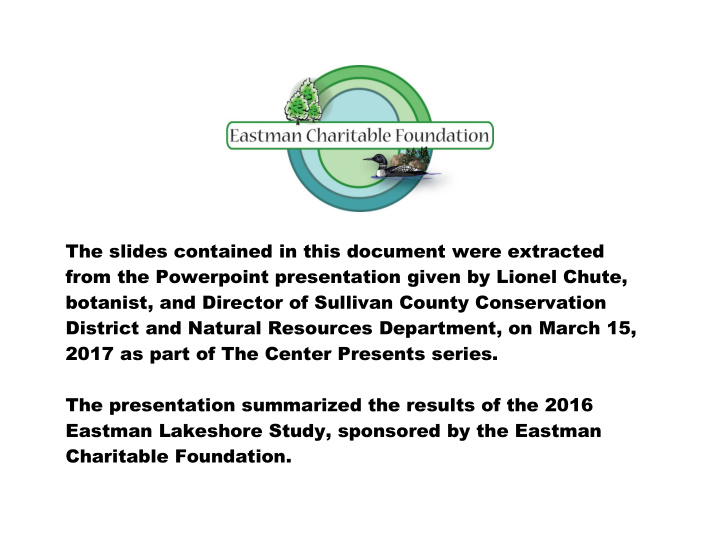



The slides contained in this document were extracted from the Powerpoint presentation given by Lionel Chute, botanist, and Director of Sullivan County Conservation District and Natural Resources Department, on March 15, 2017 as part of The Center Presents series. The presentation summarized the results of the 2016 Eastman Lakeshore Study, sponsored by the Eastman Charitable Foundation.
• Hemlock - oak - northern hardwood forest (S4) ________________________________________________________________________ _________ GENERAL DESCRIPTION: This is a common mixed coniferous - deciduous forest of middle elevations (800–1,500 ft. elevation) in central New Hampshire. It also occurs as more isolated patches on mesic sites in southern parts of the state, and in valley- bottom settings in the mountains (locally to 2,000 ft. elevation). The canopy is characterized by a mix of classic northern hardwood species such Acer saccharum (sugar maple), Betula alleghaniensis (yellow birch), and Fagus grandifolia (American beech), along with (Tsuga canadensis) hemlock. Quercus rubra (red oak) and Pinus strobus (white pine) are also typically present, but diminish in abundance in examples in the mountains or at higher elevations. This community is found primarily on moderately well to well drained soils (occasionally somewhat poorly drained) of coarser parent materials (particularly compact till and firm ablation tills) and sometimes on outwash, kame-terraces, and shallow-to-bedrock soils. Soils are generally acidic and moderately nutrient poor. CHARACTERISTIC VEGETATION: Hemlock and American beech are the primary late- successional tree species. Red oak and yellow birch are often present as associates. Other trees are less constant and more variable in prominence including sugar maple, white pine, Fraxinus americana (white ash), Acer rubrum (red maple), Picea rubens (red spruce), and Abies balsamea (balsam fir). The most consistent plants in the shrub
layer are Acer pensylvanicum (striped maple) and Viburnum lantanoides (hobblebush) but they are typically somewhat sparse. Herbs that are more abundant or frequent than in typical northern hardwoods include Medeola virginiana (Indian cucumber root), Mitchella repens (partridge-berry), and Coptis trifolia (three-leaved goldthread). Herbs that are more abundant than in most hemlock - beech - oak - pine forests include Oxalis montana (northern wood sorrel), Dryopteris intermedia (evergreen wood fern), and Huperzia lucidula (shining firmoss).
Recommend
More recommend